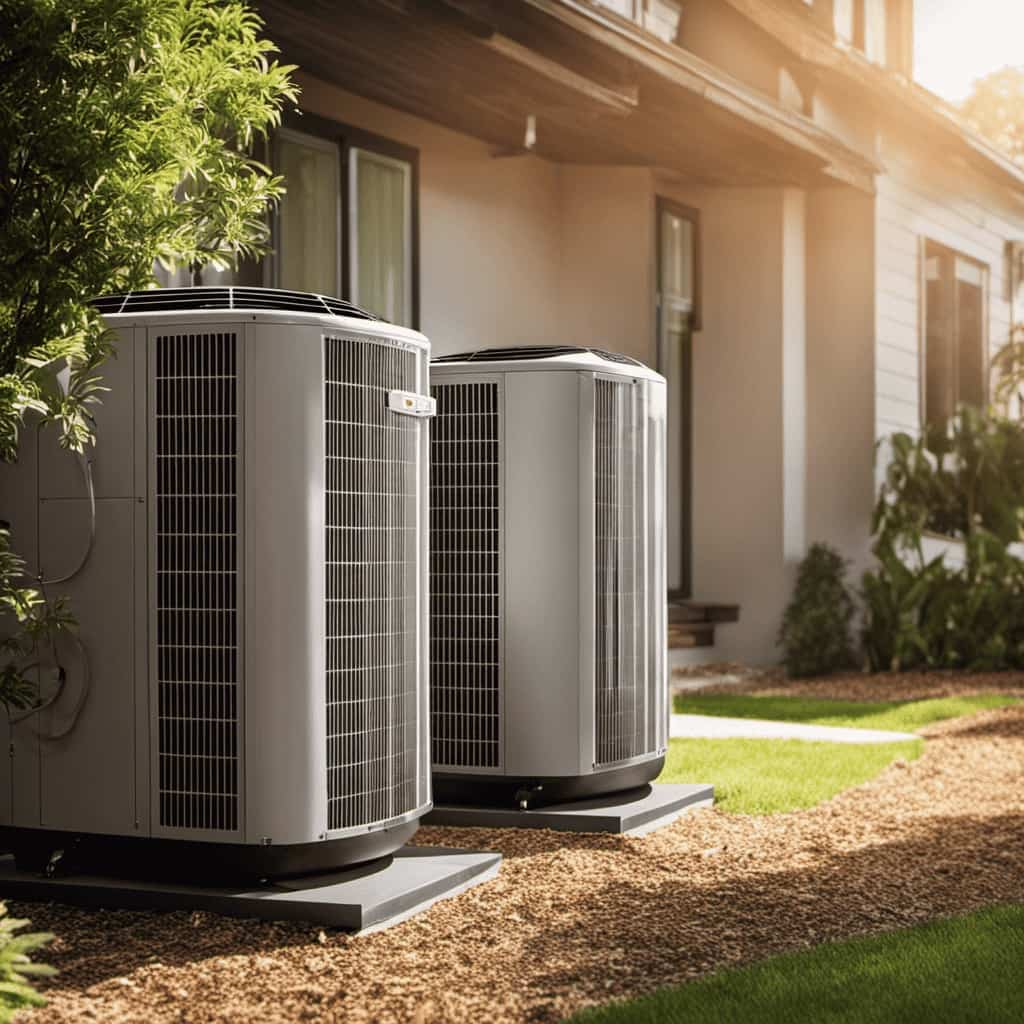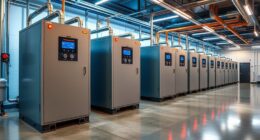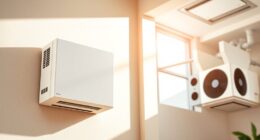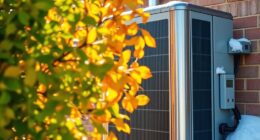We are knowledgeable about the tips and tricks for maintaining the efficiency of your HVAC heat pump.
We’ve got the inside scoop on how to maintain your system like a pro.
From regular cleaning to checking electrical connections, we’ve got you covered.
Don’t let your heat pump go unnoticed – follow our expert tips and tricks to ensure optimal performance.

Get ready to take control of your HVAC system and keep it in top shape with our insider knowledge.
Key Takeaways
- Regular maintenance is essential for the proper functioning and longevity of HVAC heat pumps.
- Neglecting maintenance can lead to reduced efficiency, increased energy consumption, strange noises, and poor air quality.
- Cleaning and changing air filters is crucial for optimal performance and energy efficiency.
- Regularly checking and cleaning coils, lubricating moving parts, and other maintenance tasks are important for HVAC heat pump maintenance.
Importance of Regular Maintenance
Regular maintenance is essential for the proper functioning and longevity of our HVAC heat pumps. It’s of utmost importance to have professional maintenance performed on a regular basis. Neglecting the maintenance of our HVAC heat pumps can lead to various issues and costly repairs down the line.
Signs of neglect can include reduced efficiency, increased energy consumption, strange noises, and poor air quality. By investing in professional maintenance, we can ensure that our heat pumps are operating at their optimal capacity. This includes cleaning or replacing air filters, checking refrigerant levels, inspecting electrical connections, and lubricating moving parts.
Regular maintenance not only helps prevent major breakdowns but also improves energy efficiency and extends the lifespan of our HVAC heat pumps. Now that we understand the importance of regular maintenance, let’s delve into understanding the heat pump system in more detail.
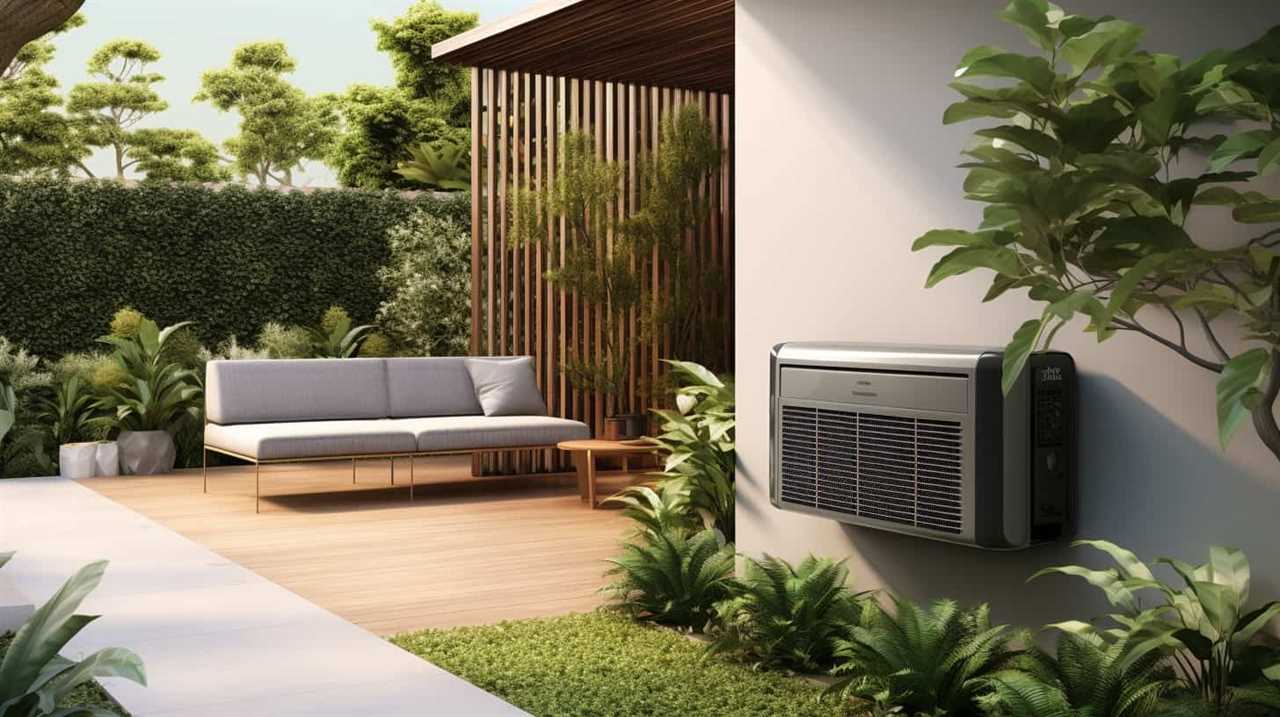
Understanding the Heat Pump System
Let’s explore the intricacies of the heat pump system to gain a comprehensive understanding of its functionality and components.
The heat pump operation involves the transfer of heat from one place to another using refrigerant and a compressor.
To troubleshoot common issues with heat pumps, it’s important to familiarize yourself with the following key components:
- Evaporator coil: This coil absorbs heat from the indoor air.
- Condenser coil: This coil releases heat to the outdoor air.
- Refrigerant: This substance carries heat between the coils.
- Compressor: This device circulates the refrigerant and increases its pressure.
Understanding how these components work together can help diagnose and resolve common problems such as insufficient heating or cooling, unusual noises, or poor airflow.

Now that we’ve a solid understanding of the heat pump system, let’s move on to the next section about cleaning and changing air filters.
Cleaning and Changing Air Filters
When it comes to HVAC heat pump maintenance, one crucial aspect is cleaning and changing air filters. Regularly cleaning and replacing air filters is essential to ensure optimal performance and energy efficiency of the system.
Frequency of Filter Changes
We should regularly clean and change our air filters to ensure proper maintenance of our HVAC heat pump. Neglecting filter changes can lead to reduced system performance and even damage to the heat pump.
Here are some important points to consider regarding the frequency of filter changes:
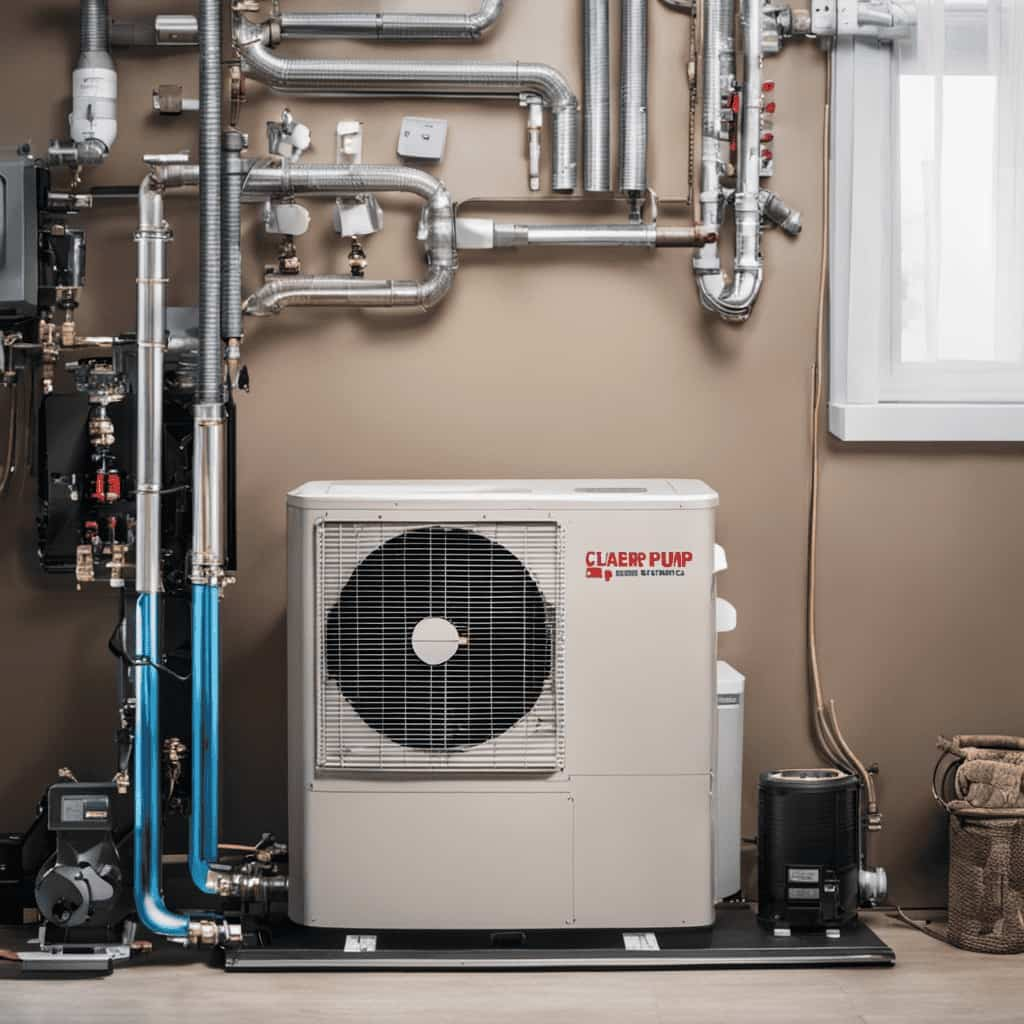
-
Signs of clogged filters and troubleshooting filter problems:
-
Reduced airflow and weaker heating or cooling performance
-
Increased energy consumption and higher utility bills
-
Excessive dust accumulation on furniture and surfaces

-
Common mistakes in filter maintenance and tips for extending filter lifespan:
-
Not following the manufacturer’s recommendations for filter replacement intervals
-
Using low-quality filters that clog faster and provide inadequate filtration
-
Failing to clean reusable filters regularly

Regular filter changes not only ensure better air quality but also have a significant impact on energy efficiency. By keeping the filters clean, the heat pump can operate more effectively, resulting in lower energy consumption and cost savings.
Impact on Energy Efficiency
Regularly cleaning and changing air filters has a direct impact on the energy efficiency of our HVAC heat pump. It’s one of the most important energy saving tips that homeowners should follow.
Air filters play a crucial role in maintaining the proper airflow and indoor air quality of our heating and cooling systems. Over time, these filters can become clogged with dirt, dust, and other debris, leading to common energy efficiency issues.
A dirty or clogged filter restricts the airflow, forcing the heat pump to work harder to maintain the desired temperature. This not only increases energy consumption but also puts unnecessary strain on the system, potentially leading to costly repairs.

Checking and Cleaning Coils
To effectively maintain our HVAC heat pump, it’s crucial to regularly check and clean the coils. Coil maintenance is essential for the proper functioning of the heat pump and to ensure optimal energy efficiency. Here are some important steps to follow when checking and cleaning the coils:
-
Inspect the outdoor coils for any signs of dirt, debris, or damage.
-
Use a soft brush or a vacuum cleaner with a brush attachment to gently remove dirt and debris from the coils.
-
If the coils are heavily soiled, consider using a coil cleaner specifically designed for the HVAC system.

-
Check the indoor coils for any signs of dirt or blockage.
-
Clean the indoor coils using a soft brush or a vacuum cleaner with a brush attachment.
-
Ensure that there are no obstructions around the coils that may restrict airflow.
Regular coil maintenance can prevent issues such as reduced cooling or heating efficiency, system breakdowns, and increased energy consumption. By troubleshooting coils and keeping them clean, you can ensure the longevity and optimal performance of your HVAC heat pump.

Lubricating Moving Parts
Regular lubrication of the moving parts in an HVAC heat pump is crucial for optimal performance and longevity. Without proper lubrication, these components can experience excessive wear and tear, leading to decreased efficiency and potential breakdowns.
To ensure effective lubrication, it’s essential to use the correct lubricant and apply it according to manufacturer guidelines, taking into account factors such as temperature and load.
Importance of Regular Lubrication
We need to regularly lubricate the moving parts of our HVAC heat pump to ensure proper functioning and prevent unnecessary wear and tear. Proper lubrication techniques are essential in maintaining the efficiency and longevity of our heat pump.
Here are two benefits of regular lubrication:

- Improved Performance:
- Lubricating the moving parts reduces friction, allowing them to move smoothly and efficiently.
- This minimizes energy consumption and ensures that the heat pump operates at optimal levels.
- Extended Lifespan:
- Regular lubrication prevents excessive wear and tear on the components.
- By reducing friction and preventing overheating, the heat pump’s lifespan is extended, saving us from costly repairs and replacements.
Proper Lubricant Application
We always ensure proper lubricant application when lubricating the moving parts of our HVAC heat pump to maintain optimal performance and prevent excessive wear and tear.
Selecting the right lubricant is crucial for the smooth functioning of the heat pump. It’s important to choose a lubricant that’s specifically designed for HVAC systems and can withstand the high temperatures and pressures involved. Additionally, the lubricant should have good compatibility with the materials used in the heat pump.
When applying the lubricant, we follow proper lubrication techniques to ensure even distribution and adequate coverage of the moving parts. This includes applying the lubricant in the recommended quantities and at the specified intervals.
Inspecting and Cleaning Condensate Drain
To properly maintain our HVAC heat pump, it’s important to regularly inspect and clean the condensate drain. The condensate drain is responsible for removing the water that’s produced during the cooling process. If the drain gets clogged, it can lead to various issues such as water leaks, reduced cooling efficiency, and even damage to the system.

Here are some steps to prevent clogs and troubleshoot issues with the condensate drain:
- Inspect the drain line for any signs of blockage, such as water pooling or dripping.
- Use a wet/dry vacuum to remove any debris or algae buildup from the drain line.
- Install a condensate pump if the drain line isn’t properly sloped or if there’s no gravity drain available.
- Clean the condensate pan and ensure that it’s properly aligned and functioning.
- Check the drain pan float switch to make sure it’s working correctly.
Testing and Calibrating Thermostat
Before starting the testing and calibrating process, gather the necessary tools and ensure that the thermostat is accessible.
Troubleshooting and calibrating a thermostat is an important step in maintaining the efficiency of your HVAC heat pump system.
First, check the power source of the thermostat and ensure it’s securely connected.

Next, verify that the thermostat is programmed correctly and set to the desired temperature.
If the thermostat isn’t functioning properly, it may be necessary to reset it by removing the batteries or turning off the power supply.
Additionally, check the wiring connections to ensure they’re secure.
Checking Electrical Connections
Let’s begin by inspecting the electrical connections to ensure they’re properly secured and functioning. Checking the electrical connections is crucial for the overall performance and safety of your HVAC heat pump system. Here are a few important points to consider:

-
Importance of electrical safety:
-
Ensure all power sources are turned off before inspecting the connections.
-
Wear appropriate personal protective equipment, such as gloves and safety goggles, to prevent electrical accidents.
-
Troubleshooting common electrical issues:

-
Look for loose or corroded connections and tighten or clean them as necessary.
-
Check for any signs of overheating, such as melted wires or burnt marks.
-
Verify that all wires are properly connected to their respective terminals.
By conducting a thorough inspection of the electrical connections, you can prevent potential hazards and ensure the efficient operation of your HVAC heat pump system.

Now, let’s move on to the next section where we’ll discuss professional maintenance tips and tricks to keep your heat pump running smoothly.
Professional Maintenance Tips and Tricks
We have compiled five professional maintenance tips and tricks to help you ensure the optimal performance and longevity of your HVAC heat pump system.
-
Regular Filter Replacement: Clean or replace your air filters every 1-3 months depending on usage. Clogged filters restrict airflow, reducing efficiency and causing strain on the system.
-
Coil Cleaning: Dirty coils can reduce heat transfer and efficiency. Use a soft brush or vacuum cleaner to remove debris and dirt from both the evaporator and condenser coils.

-
Lubricate Moving Parts: Proper lubrication reduces friction and wear on moving parts. Check the owner’s manual for recommended lubricants and apply them to bearings, motors, and other components.
-
Check Refrigerant Levels: Low refrigerant levels can indicate a leak or other issues. Monitor refrigerant levels regularly and consult a professional if you notice a decrease.
-
Schedule Professional Maintenance: Regular professional maintenance is essential for identifying and troubleshooting common issues. A comprehensive HVAC maintenance checklist includes inspection, cleaning, and performance testing of all system components.
Frequently Asked Questions
How Often Should I Schedule Professional Maintenance for My Heat Pump?
We recommend scheduling professional maintenance for your heat pump at least once a year. Regular maintenance ensures optimal performance, extends the lifespan of your unit, and allows for early detection of refrigerant issues, maximizing efficiency and preventing costly repairs.

Can I Clean and Change My Air Filters Myself, or Should I Hire a Professional?
We can clean and change our air filters ourselves, but hiring a professional for maintenance offers benefits like thorough inspections, identifying potential issues, and ensuring optimal performance.
What Are the Signs That Indicate My Heat Pump’s Coils Need Cleaning?
Signs of dirty heat pump coils include reduced airflow, decreased cooling or heating efficiency, and ice buildup. Regular maintenance is important to prevent these issues and ensure optimal heat pump performance.
Is It Necessary to Lubricate All Moving Parts of the Heat Pump, or Only Specific Ones?
We only need to lubricate specific moving parts of the heat pump. Proper lubricating techniques can prevent common heat pump issues and extend its lifespan. Consult the manufacturer’s guidelines for the recommended lubrication schedule.
How Can I Test and Calibrate My Thermostat to Ensure It Is Functioning Correctly?
To troubleshoot thermostat issues and ensure its functionality, test the calibration. Check for temperature discrepancies using a separate thermometer and adjust the thermostat’s settings accordingly. This thorough testing helps identify and address any potential issues.
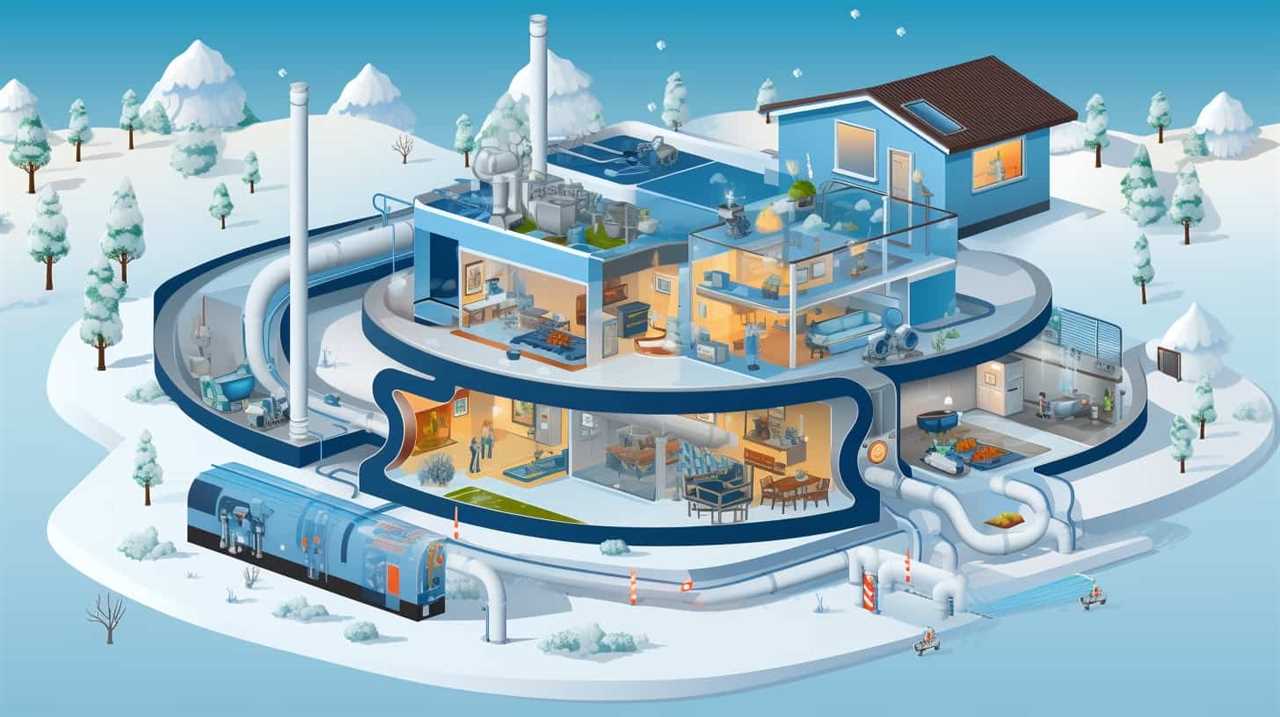
Conclusion
In conclusion, regular maintenance is crucial for ensuring optimal performance and prolonging the lifespan of your HVAC heat pump system.
By understanding the various components and following a systematic cleaning and inspection routine, you can prevent issues and maintain efficient operation.
From cleaning air filters and coils to lubricating moving parts and checking electrical connections, these insider secrets will help you keep your heat pump running smoothly.
Remember, investing time in professional maintenance will save you money in the long run.


